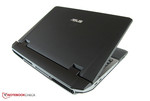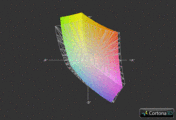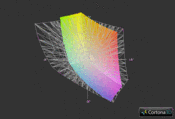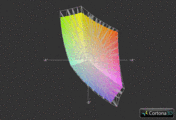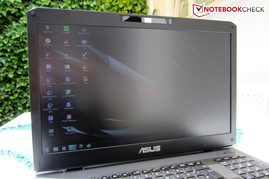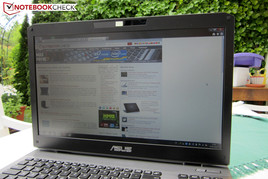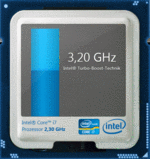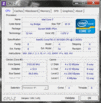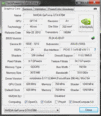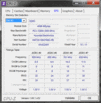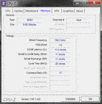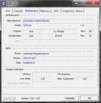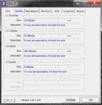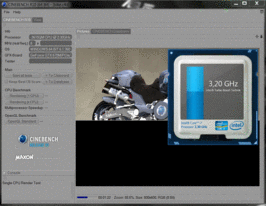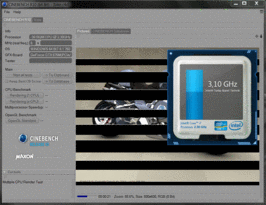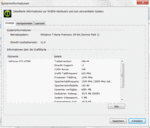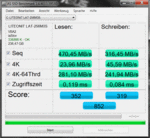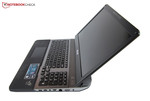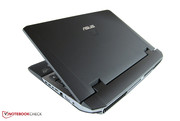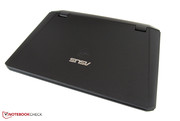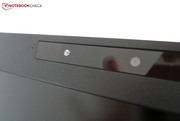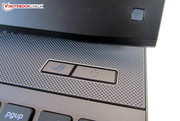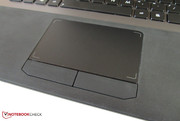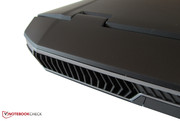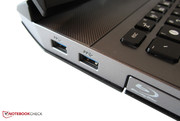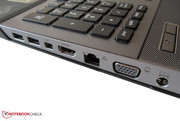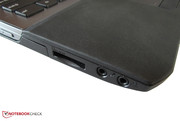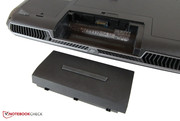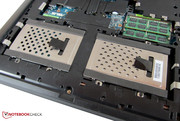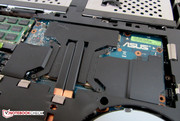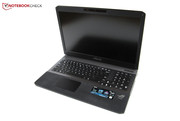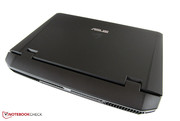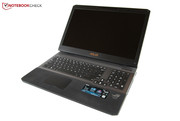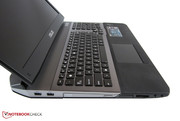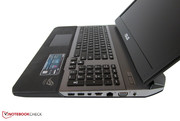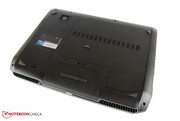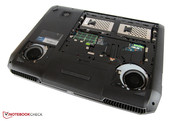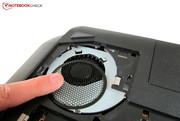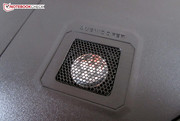Update Review Asus G75VW-T1040V Notebook
If you fancy the newest gaming laptop from Asus, you'll currently discover four particularly interesting models in Europe. The most expensive model, the G75VW-91026V, is similar to our first test sample. The 256 GB SSD and 120 Hz capable (3D ready) non-glare display are selling points.
The G75VW-T1040V under review only features a standard 60-Hz display without 3D Vision support, but is 200 Euros (253 USD) cheaper (1800 vs. 2000 Euro)(2275 vs. 2527 USD). The G75VW-T1115V is another 200 Euros cheaper. The 1600 Euro (2022 USD) model does not feature a Solid State Drive and only a 750 GB HDD (the two models with SSDs mentioned above additionally feature a 1000-GB HDD). We would not recommend the cheapest model, the G75VW-T1124V (~1500 Euro)(1896 USD), to gamers as it only features the weaker GeForce GTX 660M instead of the powerful GeForce GTX 670M.
All models are similar with regards to processor, RAM capacity and drive. They are all equipped with an Ivy-Bridge quad-core CPU. Depending on the load the Core i7-3610QM clocks between 2.3 and 3.3 GHz. 8 GB DDR3 RAM should suffice in the next years. To attract film fans, there is also a built in Blu-ray Combo Laufwerk that both plays CDs and DVDs and burns them.
To summarize, Asus offer a balanced range of products, but the price might be too high.
Case
Fortunately the production model does not have the shortcomings we criticized in the pre series model. Parts neatly adjoin each other and the drive panel no longer comes off. The case weighs 4.3 kg (9.5 pounds) and we appreciate its unique design, the comfortable rubber surfaces, and the metal keyboard base. Compared to other gaming notebooks the G75 appears to be of quite high quality. The decent stability is a further plus.
Connectivity
The connectivity is decent, but not excellent. While the left side houses two USB-3.0 ports, a card reader and two audio jacks, the right side provides two video interfaces (VGA & HDMI), an RJ-45 Gigabit LAN port, a Thunderbolt/DisplayPort interface and another two USB 3.0 ports.
Thunderbolt? Didn't we mention a DisplayPort in the previous review? Asus list a mini display port on their homepage, but the icon (a thunderbolt) remains on the Thunderbolt logo. Asus hinted that the G75/G55 won't feature Thunderbolt before autumn at the Computex (we reported). Anyway, we will discuss this topic with the manufacturer.
As this is a production model we could finally assess the scope of delivery. Alike most competitors Asus do not provide a Recovery DVD, but only a driver and tool DVD, a small user guide, a warranty pamphlet and some cable straps. The Wi-Fi module (Atheros AR9485WB-EG) and the excessive software installation (bloatware!) weren't touched since our last review.
Strange: The laptop sometimes requires USB devices to be plugged a second and third time before it recognizes them.
Input Devices
The German keyboard holds no surprises. Similar to the English or American model (see review), the local model also has a sophisticated layout, which allows fast familiarization. Only the combined Ins/Del key is somewhat annoying. The adjustable, white, back-lit keyboard is the absolute highlight.
Display
Contrary to the more expensive model the display of the G75VW-T1040V is not 3D capable. Asus impressively demonstrate that games and films do also look nice without 3D-Vision support (which requires a 120-Hz display).
Also other gaming notebooks like the MSI GT70 use the 17.3-inch Chi Mei N173HGE display (CMO1720) because of its good image quality. Though the matte surface looks slightly grainy, it is easy to neglect this flaw because of its "inner" values.
| |||||||||||||||||||||||||
Brightness Distribution: 82 %
Center on Battery: 272 cd/m²
Contrast: 800:1 (Black: 0.34 cd/m²)
64.2% AdobeRGB 1998 (Argyll 3D)
87.5% sRGB (Argyll 3D)
64.1% Display P3 (Argyll 3D)
Although the brightness of about 260 cd/m² cannot keep up with the LGD02C5 display of the 3D model, it is above average in brightness. The display remains easily legible on bright days. Subjectively, the brightness distribution is uniform and the calculated value was slightly above 80%.
Compared to the 3D model the advantage of the lower brightness is that the black value is amazingly low (0.34 vs. 0.61 cd/m²). The lower the black value, the less grayish dark elements appear (e.g. night scenes in videos and games).
The two displays are on par in terms of contrast. The G75VW-T1040V achieves an excellent contrast ratio of 800:1. The color space is also decent - pictures look good.
Performance
Processor
The Core i7-3610QM is a quad-core from Intel's current Ivy Bridge generation. The high-end CPU is produced in 22nm process and houses 1.4 billion transistors, six MB L3 Cache and a graphics chip called HD Graphics 4000. As Asus did not implement any graphics switch, the later remains unfortunately inactive.
If you use professional applications, you'll appreciate Hyper Threading, which adds a virtual core to each physical core. Therefore, the quad-core can process eight threads in parallel.
Turbo Boost
CPU Performance
The performance of the Core i7-3610QM is good throughout. Although the quad-core CPU calculates about 10% slower than the more expensive Core i7-3720QM (6.15 vs. 6.8 points in Cinebench R11.5), it is sufficient for current and coming games.
Graphics Card
It's more likely that the graphics card will become obsolete in the next few years. The DirectX 11 capable GeForce GTX 670M is not based on Nvidia's new Kepler architecture (28 nm), but - as is the GeForce 500 series - still on the old Fermi technology (40 nm). The mid-range GT 640M (Acer Aspire M3-581TG) and GT 650M (One M73-2O) already impressively demonstrated what the new architecture is capable of. Especially in terms of energy efficiency Nvidia has improved a lot.
Asus offer a model with 3072 MB GDDR5-VRAM, which features 336 shaders (CUDA cores), 1950 million transistors and a 192 Bit memory interface. The core clocks at 620 MHz, and the memory at 1500 MHz.
GPU Performance
Compared to AMD's current flagship, the Radeon HD 7970M, the GTX 670M is noticeably slower. While the Nvidia model achieves decent 39.0 fps in Unigine Heaven (1280 x 1024), the competitor from AMD achieves about double with 80.1 fps (Alienware M17x R4).
In the 3DMark 11 (1280 x 720, GPU score) the scores also differ significantly: The GTX 670M is about 50% slower (2703 vs. 5514 points). The more expensive GTX 675M achieves 47.2 fps and 3272 points and barely performs better (Schenker XMG P702 PRO).
| 3DMark 05 Standard | 27372 points | |
| 3DMark 06 Standard Score | 19666 points | |
| 3DMark Vantage P Result | 12670 points | |
| 3DMark 11 Performance | 3005 points | |
Help | ||
Mass Storage
The solid state drive is the same as in the pre production model. Asus use a rather unknown product from Lite-On, the LAT-256M3S. According to our benchmarks this is a fantastic choice.
With a sequential read rate of 471 MB/s and a sequential write rate of 316 MB/s (AS SSD Benchmark) the Lite-On model models itself on Samsung's powerful SSD 830 (compare Schenker XMG P702 PRO). The gaming notebook can also handle smaller files well. The low access times (0.12 ms read & 0.08 ms write) also deserve praise.
In addition the laptop features a 1000 GB HDD. Although it's only a 5400 rpm drive, the Samsung Spinpoint M8 is relatively fast and achieves 123 MB/s in CrystalDiskMark.
System Performance
Thanks to a quad-core CPU, a high-end graphics and an SSD you are ideally equipped for everyday life. System benchmarks like PCMark Vantage illustrate the excellent system performance. 20075 points prove that this is an outstanding gaming laptop. Because of a bigger RAM capacity (16 vs 8 GB) and the faster CPU (3720QM vs. 3610QM) our test model was even faster (20517 points).
| PCMark Vantage Result | 20075 points | |
| PCMark 7 Score | 4788 points | |
Help | ||
Gaming Performance
If anti-aliasing is not set too high, you can enjoy most of the games with high or maximum details in the native Full HD resolution. The G75 can even run current blockbusters like Diablo III, Max Payne 3 and Dirt Showdown. It's hardly ever necessary to reduce the graphics settings (e.g. Battlefield 3). Further gaming benchmarks are available in our first review.
| low | med. | high | ultra | |
|---|---|---|---|---|
| Batman: Arkham City (2011) | 66 | 29 | ||
| Battlefield 3 (2011) | 47.6 | 20.1 | ||
| Risen 2: Dark Waters (2012) | 47.8 | 22.7 | ||
| Diablo III (2012) | 80.8 | 59 | ||
| Dirt Showdown (2012) | 73.4 | 29.8 | ||
| Max Payne 3 (2012) | 75.2 | 71 | 27.9 | 22.8 |
Emissions
System Noise
Although the G75 is not as quiet as its predecessors, the G73 and G74 in 3D mode, the 17-incher is significantly quieter than most of its competitors. While most high-end notebooks exceed the 40 db level during 3DMark 06, the fans of the G75 spin at fully acceptable 36-38 dB (distance: 15 cm). The gamer notebook gets clearly audible only under full load.
During idle or simple tasks, the fan is restrained and you'll only hear the noise of the HDD. Meanwhile, noise from the Blu-ray player is only noticeable during fast forward and rewind.
Noise level
| Idle |
| 29.9 / 30.9 / 31.2 dB(A) |
| HDD |
| 30.9 dB(A) |
| DVD |
| 35.5 / dB(A) |
| Load |
| 37.3 / 42.8 dB(A) |
 | ||
30 dB silent 40 dB(A) audible 50 dB(A) loud |
||
min: | ||
Temperature
Moderate temperatures are another reason to buy this notebook. The case does not even get excessively hot under heavy load. After one hour stress test with FurMark and Prime the temperature increased to 33 °C. While idle, the notebook even remains cooler at about 28 °C.
However, whether the G75 throttles under full load was of more interest for us, as the CPU clock dropped to 1.2 GHz in the pre production model after some time. To make it short: Throttling is a thing of the past as the Core i7-3610QM clocked at about 3.1 GHz. Despite high clock rates, the components do not reach critical values. Peak values of 85 °C for processor and graphics card (CPUID Hardware Monitor) are absolutely fine.
(+) The maximum temperature on the upper side is 37.2 °C / 99 F, compared to the average of 40.4 °C / 105 F, ranging from 21.2 to 68.8 °C for the class Gaming.
(+) The bottom heats up to a maximum of 39.8 °C / 104 F, compared to the average of 43.3 °C / 110 F
(+) In idle usage, the average temperature for the upper side is 27.6 °C / 82 F, compared to the device average of 33.9 °C / 93 F.
(+) The palmrests and touchpad are cooler than skin temperature with a maximum of 30.4 °C / 86.7 F and are therefore cool to the touch.
(±) The average temperature of the palmrest area of similar devices was 28.8 °C / 83.8 F (-1.6 °C / -2.9 F).
Speakers
The built-in 2.1 sound system still does not knock our socks off. Although the subwoofer on the bottom side provides a halfway decent bass, low tones sound somewhat dull. Meanwhile, the two speakers emphasize high notes. Furthermore, the sound is relatively tinny compared to an external sound system. In this case Asus takes a step backwards; previous models offered better sound.
Battery Life
Power Consumption
As the standard G75 models are less bright, they achieve a somewhat higher battery life. While the model with 120 Hz display shuts down after less than three hours, the 60 Hz models achieve just less than four hours under ideal conditions (idle, lowest brightness). Two hours film playback and 2.5 hours web surfing are also decent for a gaming notebook (good to maximum brightness).
The 17-incher is hardly appropriate for mobile gaming. The computationally intensive Classic Test from Battery Eater already stopped after 75 minutes. Despite occasional problems (see Max Payne 3), we wish the successor could implement a graphics switch.
| Off / Standby | |
| Idle | |
| Load |
|
Key:
min: | |
Battery Life
As the »standard« G75 models are less bright, they achieve a somewhat higher battery life. While the model with 120 Hz display shuts down after less than three hours, the 60 Hz models achieve just under four hours under ideal conditions (idle, lowest brightness). Two hours film playback and 2.5 hours web surfing are also decent for a gaming notebook (good to maximum brightness).
The 17-incher is hardly appropriate for mobile gaming. The computationally intensive Classic Test from Battery Eater already stopped after 75 minutes. Despite occasional problems (see Max Payne 3), we would wish the successor could implement a graphics switch.
Verdict
Our first verdict is mostly also true for the production model. The G75VW-T1040V from Asus is a successful and sophisticated gaming laptop with hardly any flaws – apart from its weight.
Besides high build quality, decent input devices, and low noise and temperature emissions, we have to mention the matte Full HD panel positively. Gamers and film fans will not only appreciate the low black value, but also the excellent contrast.
The components also seem to be selected wisely. However the graphics cards might be too slow in the future. Due to the steep price of 1800 Euro (2275 USD), many gamers will consider twice before buying. If you do not mind system noise, you'll get cheaper and/or faster products from competitors.
Accepting that the graphics card may be a limiting factor in the future: The G75VW-T1040V is without a doubt one of the best high-end notebooks available today.





